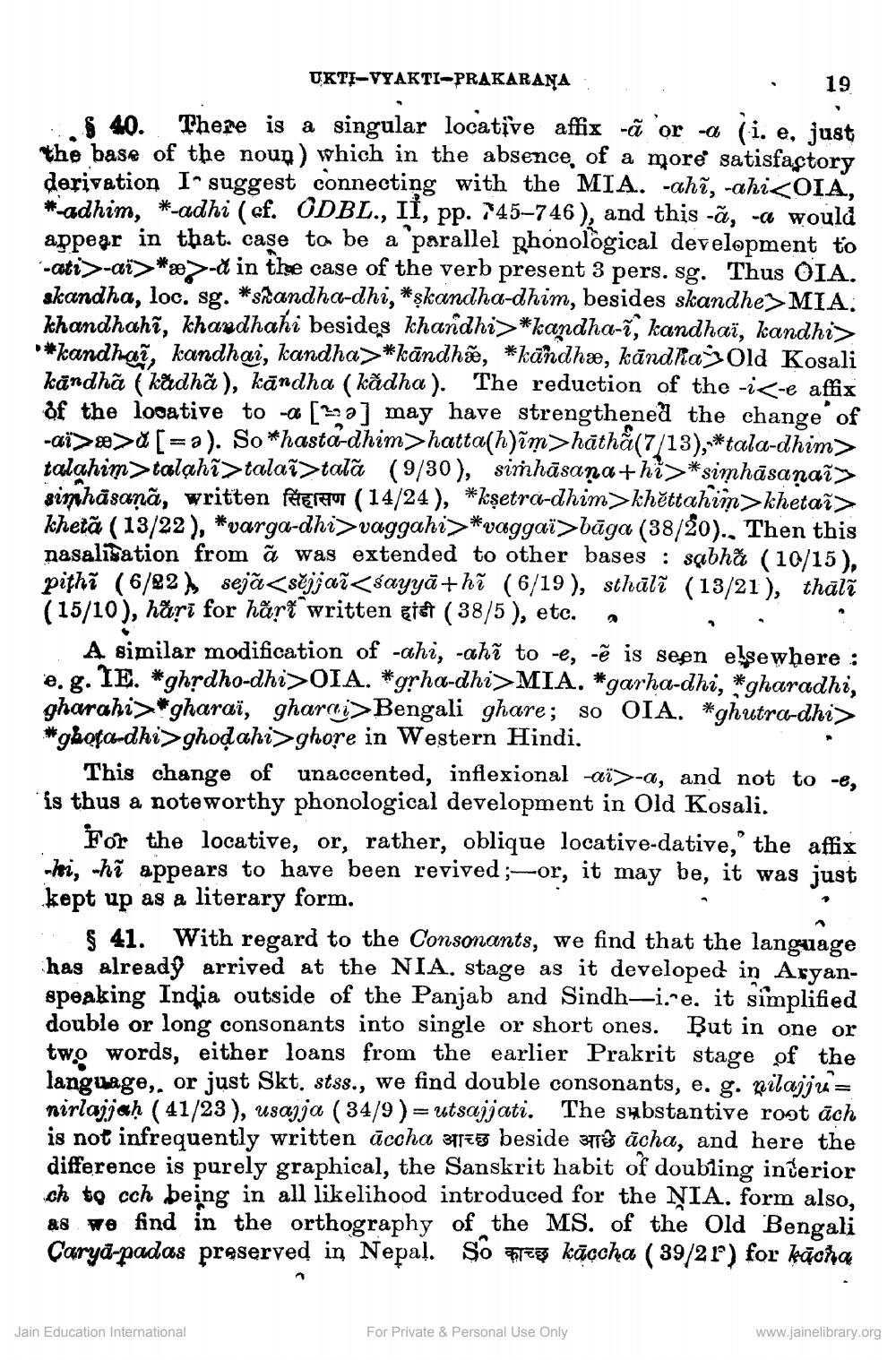________________
UKTI-VYAKTI-PRAKARANA
. 19 40. There is a singular locative affix ã'or -a (i. e, just the base of the noun) which in the absence of a more satisfactory derivation Insuggest connecting with the MIA. -ahî, -ahi<DIA, *adhim, *adhi (cf. ODBL., II, pp. 745–746), and this -a, -c would appear in that. case to be a parallel phonological development to -ooti>-«i>**>-& in the case of the verb present 3 pers. sg. Thus OIA. skandha, loc. sg. *sRandha-dhi, *skandha-dhim, besides skandhe] MIA. khandhahi, khandhahi besides khandhi> *kandha-, kandhaï, kandhi> "*kandhal, kandhai, kandha>*kāndhã, *kāndhæ, kāndha; Old Kosali kāndhã ( kadhã), kārdha ( kādha). The reduction of the -iz-e affix of the locative to -a [259] may have strengthened the change of -ai > >[=a). So *hasta-dhim>hatta(h)īm>hāthă(7/13), *tala-dhim> talahim>talahī>talaž>tałã (9/30), simhāsana+hi>*simhâsanały simhāsaņā, written FETT (14/24), *kşetra-dhim>khéttahim>khetaž> kheta (13/22), *varga-dhi>vaggahi>*vaggaï>bāga (38/20). Then this nasalisation from ã was extended to other bases : sabhã (10/15), pithi (6/22), sejā<séjj až<sayyā+hĩ (6/19), sthālī (13/21 ), thālī (15/10), hări for hårt written giet (38/5), etc.
i A similar modification of -ahi, -ahi to -e, -ē is seen elsewhere : e.g. IE. *ghrdho-dhi>OIA. *grha-dhi>MIA. *garha-dhi, *gharadhi, gharahi>*gharaï, gharci>Bengali ghare; so OIA. *ghutra-dhi> *gkoto-dhi>ghodahi>ghore in Western Hindi.
This change of unaccented, inflexional aï>-a, and not to -e, 'is thus a noteworthy phonological development in Old Kosali.
For the locative, or, rather, oblique locative-dative,' the affix -hi, -hi appears to have been revived ;-or, it may be, it was just kept up as a literary form.
41. With regard to the Consonants, we find that the language has already arrived at the NIA. stage as it developed in Aryanspeaking India outside of the Panjab and Sindh—i. e. it simplified double or long consonants into single or short ones. But in one or two words, either loans from the earlier Prakrit stage of the language, or just Skt. stss., we find double consonants, e. g. Kilajja= nirlajjah ( 41/23), usajja ( 34/9 )= utsajjati. The substantive root äch is not infrequently written ūccha 31173 beside spre acha, and here the difference is purely graphical, the Sanskrit habit of doubling interior ch to cch being in all likelihood introduced for the NIA. form also, as we find in the orthography of the MS. of the Old Bengali Carya-padas preserved in Nepal. So pag kāccha ( 39/2r) for kacha
Jain Education International
For Private & Personal Use Only
www.jainelibrary.org




